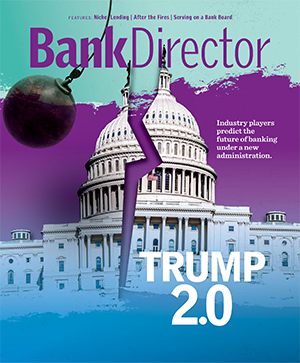
Is Your Bank Ready for Basel III Compliance?
Brought to you by Fiserv


The first implementation deadlines are looming for the standards in the Third Basel Accord, commonly known as Basel III. It’s time for bank directors to make sure they’re up to speed.
Basel III comes into play at a time of worldwide economic uncertainty. Promulgated by the Basel Committee on Banking Supervision, the international forum for supervisory matters based in Basel, Switzerland, this comprehensive set of regulations seeks to instill greater stability and confidence in the banking system by dealing with deficiencies exposed by the financial crisis of the late 2000s.
The Basel III framework includes six key requirements for banks:
- Hold more and better-quality liquidity
- Maintain more and better-quality capital
- Achieve enterprise risk management maturity
- Ensure robust, comprehensive stress testing
- Enhance capital adequacy assessments
- Integrate comprehensive and actionable capital and strategic planning
A new risk-weighted capital framework to determine regulatory capital adequacy based on Basel III becomes effective for community banking organizations (non-complex, with assets between $500 million and $10 billion) on January 1, 2015.
Community Bank Readiness
Many managers and officers of community banks and small regional banks have told me they believe Basel III is really not an issue for them because they’re extremely well-capitalized. However, if these bankers haven’t run the Basel III calculator provided on each banking regulator’s website, their confidence may not be warranted. The risk ratings under Basel III are radically different from anything we’ve seen in the past. And you can’t determine true capital adequacy simply and solely on the basis of the new regulatory capital ratios. Those ratios are merely the ante into the game, the minimum requirement.
In today’s banking environment, the only true measure of capital adequacy is economic capital measured in a customized way for each financial institution, stress-tested to consider all risk elements across the full probability spectrum. A fresh assessment and approach are needed before you can say you’re well-capitalized in a Basel III world.
A Board Responsibility
Basel III should be a top-of-mind concern with every member of the board. Directors have a critical fiduciary role in ensuring Basel III compliance, and in capital and strategic planning in general. The board should be front and center in these areas:
- Defining risk appetite. First and foremost, boards of directors must define the level of risk that is acceptable for their organizations. Within acceptance of that risk, they must determine what commensurate returns they expect the financial institution to earn.
- Scenario planning. Through stress testing and scenario planning, boards of directors should look at all potential outcomes and their impact on capital, from low- to high-probability events. Directors should help frame some of these scenarios and stress tests, and thoroughly understand the results. The board must also have a firm grasp on how integrated strategic and capital plans are driving decision making—including risk assumption, resource allocation and the tactical actions of the organization.
- Right-sizing capital. The board of directors must be instrumental in making sure that the bank’s capitalization properly aligns with the risks assumed by its banking business model. I am an advocate for the “Goldilocks School of Banking.” Like the porridge sampled by the little blonde-haired girl, capital needs to be “just right”—neither too much nor too little, and customized for the financial institution.
RAROC: The One True Metric
Risk-adjusted return on capital (RAROC) is the most all-encompassing performance indicator your organization can employ in assessing your capital position. It is the only metric that considers both full risk and potential return in a strategic business equation.
RAROC is suitable for assessing your total organization, individual business units, products, customers and customer segments. It enables you to determine your economic capital and capital adequacy, while helping optimize how you allocate capital and resources. Risk-adjusted analysis helps your organization intelligently price customer transactions, evaluate profitability, incentivize employees and right-size capital to your risk profile.
The benefits of RAROC are substantial and far-reaching. I encourage your board to insist on using this important tool.
Getting Started
Basel III awareness and compliance begin with the board asking two things of management:
- Education. Whether it’s provided by the executive team or an outside consultant, the board should insist on a one- to two-hour overview of Basel III—not just focusing on what the regulations require, but also the implications for your banking business model and a strategy to respond.
- Basel III status report. The board must ask if the executive team has run the pro forma calculations for Basel III capital compliance, and where the capital levels stand today in light of Basel III requirements.
This simple, two-step questioning process is absolutely essential. If it isn’t already underway at your financial institution, it should begin at your next board meeting.
For more information on capitalization and regulatory compliance, see Orlando Hanselman’s white paper, Capital Conundrum: A Call for Clarity and Action.

